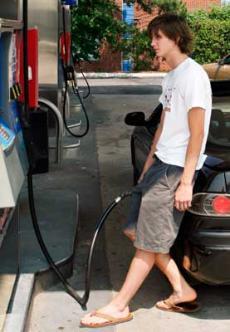
According to Sperling’s BestPlaces, Raleigh-Durham is sixth on the list of the top 10 cities worst hit by gas prices among 80 cities looked at in the nation. The factors that played into this were the price of a regular-grade gallon of gasoline, rush-hour congestion and the number of hours commuters drive daily.
If one were to use 2.8 gallons of gas per day in Raleigh-Durham, the average annual cost is about $5,066.
“Usually California gas prices are higher than Raleigh, which makes sense because California living costs in general is higher, but now that Raleigh gas prices are higher than California’s — that doesn’t make much sense to me,” Nosayba Askar, senior in microbiology, said.
Los Angeles, Calif. is ranked eighth.
Sperling’s BestPlaces linked the rising gas prices to rising home prices in cities, which leads families to move farther away and have longer commutes.
People like sociology lecturer Lori Heald have a full family of commuters and are, therefore, used to higher gas prices.
“I live in Spring Hope and it takes about an hour to get into work — before they put the bypass in, it could take up to two-and-a-half,” Heald said. “If I come into Raleigh three times a week, that’s a tank of gas, but only because I drive a little car with a little gas tank. I’ll also make a couple of local trips on the tank.”
David Haput, freshman in nuclear engineering, said that of course prices vary across the nation, but that every city is seeing a significant increase from the norm.
“Raleigh’s apparent sixth rank for hit from high gas prices has affected me the same way it affects everyone in any city that experiences rising prices — we pay more,” Haput said. “I drive a diesel truck for the most part and diesel prices seem to fluctuate less, but they still have risen.”
The type of gas bought and prices differ from station to station, and Heald says she actually has to pay more for gas in Spring Hope than in Raleigh.
“I get about 25 to 29 miles to the gallon, but I also try to buy Citgo gas — the car runs better and the gas lasts longer. A tank is about 27 bucks,” Heald said. “I went to Rocky Mount the other day, and gas was cheaper in Spring Hope, but when I went to Raleigh the next day, gas was cheaper in Raleigh. Usually, we pay a few cents more around here than in Raleigh.”
Heald said that a solution to the gas problem is a combination of many things, including Wall Street gamblers not having the authority to set prices, oil companies putting their profits to use throughout the years and a larger emphasis on other sources of fuel.
“Americans tend to forget things after a crisis blows over. We didn’t learn much from the 70s gas crisis or we would have alternative fuels now, we wouldn’t be seeing the big SUVs, etc,” she said. “So, we have to change our attitudes. I don’t think we will though, as we aren’t, as a country, cutting back, and gas prices don’t seem to affect people much; although I doubt they’re talking to the poorer folks who would be feeling the pinch.”
Heald said she remembers the 1970s when there was a shortage of gas and people had to get up at the crack of dawn to get it.
“Gas wasn’t expensive; it just wasn’t available. I’d rather have an abundance and pay more than wait in the snow and cold for a chance at it,” she said.
Heald is not the only one who thinks the problem is not easily able to be solved. Haput said the rising gas prices is not a new phenomenon and he doesn’t foresee finding a way around higher gas prices.
“As for a solution, I don’t really see a way to get around high gas prices other than not using gas or at least not using 100 percent gas,” he said.
“Of course, there’s always complete independence from Middle Eastern oil, or oil altogether, but that is most likely not going to happen soon at all. There are partial ethanol blends and cars can even run on purely ethanol, but it doesn’t seem that technology is feasible enough yet to significantly lower prices for every person across the board,” he said.